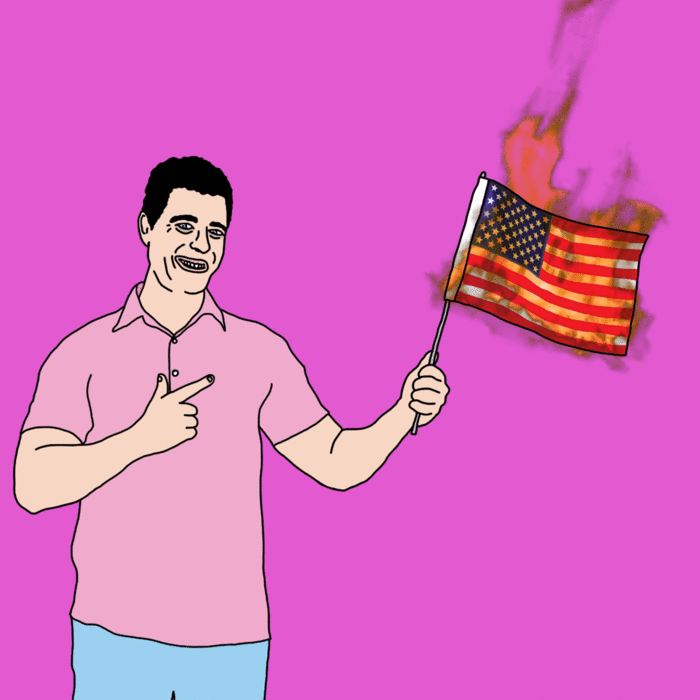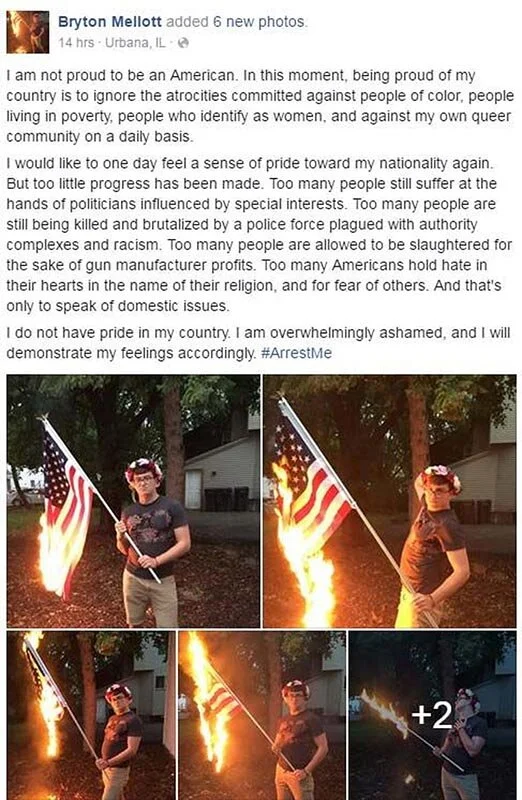Thanks To This Guy It’s Legal to Burn The American Flag
Considered a form of free speech, we’re one of the few countries that allows flag desecration, but not everyone is happy about it.
By Jessie Schiewe
Art by Zootghost
It was the most scandalous photo Bryton Mellott had ever posted to Facebook.
It wasn’t just because the 22-year-old Walmart employee was wearing a crown made of flowers. That was the least of it, although he’d later be trolled online for his fashion decision and sexual preferences.
The shock-factor of the photo had less to do with what the Indiana man was wearing than with what he was holding. Stony-faced and staring straight at the camera, the bespectacled Mellott was clutching a slender white pole. On the other end of it hung an American flag, emblazoned with flames. The date was July 4, 2016.
Mellott provided an explanation beneath the photo. In the span of three paragraphs, he explained that he was “not proud to be an American” because of the “atrocities committed against people of color, people living in poverty, people who identify as women, and against my own queer community on a daily basis.”
He continued:
“I do not have pride in my country. I am overwhelmingly ashamed, and I will demonstrate my feelings accordingly.”
He ended the blurb with: “ArrestMe.”
It didn’t take long for his wish to come true.
Within hours, Mellott was behind bars after officers from the Urbana Police Department showed up early the next morning to the Walmart where he was working a shift. By this point, his Facebook post had already stirred up substantial ire from those who were offended by his “disrespectful” flag burning, resulting in numerous threats against him and Walmart. Someone even doxed Mellott, posting his home address underneath the photo and the comment, “have fun :^)”
Intent on de-escalating the situation, police originally headed to Mellott’s place of work to have a conversation with him about removing the post. But Mellott refused to do so, leading the police to put him under arrest for flag desecration and disorderly conduct, The Washington Post reports.
When he was released later that day and slapped with a future court date, no one had a clue that in the next 24 hours, everything that had just happened to him would be erased.
Talk of Mellott’s arrest — and the question of whether it was illegal to burn the American flag — rose swiftly through the ranks of Illinois’ government, catching the attention of the State’s Attorney, Julia Rietz. Through a public Facebook post, published on July 5th, she announced her office’s decision not to file charges against Mellott. “The act of burning a flag is protected free speech,” she said, citing a 1989 U.S. Supreme Court decision that predated Illinois’ 2013 flag desecration law.
In the United States, it is legal to burn, cut, rip, shoot, damage, and otherwise destroy the American flag. We’re part of a small handful of countries that allows this, including Canada, Australia, and Denmark. Though it’s considered a form of “symbolic speech” in the U.S., desecrating a flag — and in some cases even sitting on one or merely insulting it — comes with greater consequences in most other countries.
Flag burning hasn’t always been legal in the United States. Our right to do so has only been recognized for the last 30 years. We have Gregory "Joey" Johnson to thank for this.
When Johnson, a self-described revolutionary communist, arrived at the political demonstration outside of the 1984 Republican National Convention in Dallas, Texas, he didn’t expect to become the poster boy of the flag burning movement. A 27-year-old high school dropout, he was there to protest against the Reagan administration by marching in the streets with about 100 others.
When the demonstration escalated, leading some protesters to spray-paint buildings and knock over potted plants, Gregory did not partake. But he contributed in another way. He took an American flag that a protester had stolen from a building, poured kerosene over it, and set it on fire in front of the Dallas City Hall.
As the flag burned, he reportedly chanted jargon, like:
"Reagan, Mondale, which will it be? Either one means World War III"
"Ronald Reagan, killer of the hour / Perfect example of U.S. power"
"Red, white and blue, we spit on you / You stand for plunder, you will go under"
Credit: Wikimedia Commons/Noplur
Johnson’s flag-burning antics — or, in penal code parlance, his desecration of a venerated object — led to his arrest, and he was sentenced to one year in prison and fined $2,000. He appealed the conviction and eventually his landmark case, Texas v. Johnson, worked its way up the Texas courts system until it reached the U.S. Supreme Court. Before Johnson’s case, the high court had never directly addressed the question of whether the First Amendment protected flag burning.
In 1989, six years after Johnson’s infamous pyrotechnics display, the Supreme Court handed down its decision. Flag burning, they decided in a close five-to-four ruling, is legal. It’s a form of political expression protected by the First Amendment. As Justice Anthony Kennedy explained in his concurring opinion:
“The hard fact is that sometimes we must make decisions we do not like. We make them because they are right, right in the sense that the law and the Constitution, as we see them, compel the result. And so great is our commitment to the process that, except in the rare case, we do not pause to express distaste for the result, perhaps for fear of undermining a valued principle that dictates the decision. This is one of those rare cases. … It is poignant but fundamental that the flag protects those who hold it in contempt.”
In the immediate aftermath of Texas v. Johnson, laws in 48 states that criminalized flag desecration suddenly became invalidated. Congress also tried to reverse the ruling. Before the end of the year, it passed the Flag Protection Act making it a federal crime to intentionally burn or deface the American flag. The statute, however, didn’t last long. It was struck down by the Supreme Court, with the same five-person majority of justices as in Texas v. Johnson ruling it a violation of free speech rights.
Congress has attempted to outlaw flag desecration several times since then, but has yet to be successful. Its most recent proposed constitutional amendment to ban flag burning was shot down in 2006.
President Donald Trump has also weighed in on the debacle. In 2016, he posted to Twitter that “Nobody should be allowed to burn the American flag.” If someone does, he argued that they should face consequences, including having their citizenship revoked or facing a year in jail.
As a Trump spokesperson later told CNN:
“Flag burning should be illegal. The president-elect is a very strong supporter of the First Amendment, but there’s a big difference between that and burning the American flag.”
Even with the Supreme Court’s ruling, there have been those, like Mellott, who have been unlawfully punished for burning flags.
Johnson was even arrested again in 2016 for torching a flag at the Republican National Convention in Cleveland, Ohio, despite the fact that he’d publicized his perfectly legal plans of doing so in a press release. After the charges against him were dropped, Johnson sued the city of Cleveland for violating his First Amendment rights and won $225,000.
For this upcoming Fourth of July, the now 63-year-old political dissenter plans to desecrate the national symbol once more — and this time, he hopes others will join in. Dubbing it the #FlagBurningChallenging, Johnson will be protesting against President Trump, his efforts to re-criminalize flag burning, and the current state of America.
“I am determined to defy Trump on July 4th by burning an American flag at a fitting symbol of Trump and his fascist regime,” he said. “And I’m calling on everyone who stands against injustice and oppression to join me. Be safe, don’t endanger others, but wherever you are in this country or around the world, help make this July 4th a day of defiant flag burning actions!”
Would-be protesters should be forewarned that even though flag burning is protected under the First Amendment, there are things that might still get you in trouble.
Where you are when you do it, how you do it, and what you do it to are all things to take into consideration. For instance, it would be unwise for those seeking to avoid jail time to burn a flag that isn’t their own or in a location that is on private property. Ensuring that the fire is contained and doesn’t harm or distress others is also key, as it is not unheard of for flag burners to be arrested for disorderly conduct.
Then again, destroying the national flag of one’s country is a powerful way of sending a message, but it’s not the only way. For those who want to dissent but ultimately feel that flag burning is too risky or unsafe, here’s another idea: get a flag and hang it upside down.
Credit: Wikimedia Commons/Mike Shaheen
The simple, flameless option is traditionally a symbol of “dire distress in instances of extreme danger to life or property,” according to the United States Flag Code, but protesters have been hanging flags upside down as signs of unrest with the government since at least the Vietnam War.
Just like with flag burning, not everyone is going to love it — and people might even show up at your door to discuss it — but hey, it’s still legal.

















